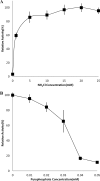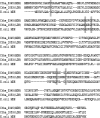Reassessment of the transhydrogenase/malate shunt pathway in Clostridium thermocellum ATCC 27405 through kinetic characterization of malic enzyme and malate dehydrogenase
- PMID: 25616802
- PMCID: PMC4357940
- DOI: 10.1128/AEM.03360-14
Reassessment of the transhydrogenase/malate shunt pathway in Clostridium thermocellum ATCC 27405 through kinetic characterization of malic enzyme and malate dehydrogenase
Abstract
Clostridium thermocellum produces ethanol as one of its major end products from direct fermentation of cellulosic biomass. Therefore, it is viewed as an attractive model for the production of biofuels via consolidated bioprocessing. However, a better understanding of the metabolic pathways, along with their putative regulation, could lead to improved strategies for increasing the production of ethanol. In the absence of an annotated pyruvate kinase in the genome, alternate means of generating pyruvate have been sought. Previous proteomic and transcriptomic work detected high levels of a malate dehydrogenase and malic enzyme, which may be used as part of a malate shunt for the generation of pyruvate from phosphoenolpyruvate. The purification and characterization of the malate dehydrogenase and malic enzyme are described in order to elucidate their putative roles in malate shunt and their potential role in C. thermocellum metabolism. The malate dehydrogenase catalyzed the reduction of oxaloacetate to malate utilizing NADH or NADPH with a kcat of 45.8 s(-1) or 14.9 s(-1), respectively, resulting in a 12-fold increase in catalytic efficiency when using NADH over NADPH. The malic enzyme displayed reversible malate decarboxylation activity with a kcat of 520.8 s(-1). The malic enzyme used NADP(+) as a cofactor along with NH4 (+) and Mn(2+) as activators. Pyrophosphate was found to be a potent inhibitor of malic enzyme activity, with a Ki of 0.036 mM. We propose a putative regulatory mechanism of the malate shunt by pyrophosphate and NH4 (+) based on the characterization of the malate dehydrogenase and malic enzyme.
Copyright © 2015, American Society for Microbiology. All Rights Reserved.
Figures







Similar articles
-
The Roles of Nicotinamide Adenine Dinucleotide Phosphate Reoxidation and Ammonium Assimilation in the Secretion of Amino Acids as Byproducts of Clostridium thermocellum.Appl Environ Microbiol. 2023 Jan 31;89(1):e0175322. doi: 10.1128/aem.01753-22. Epub 2023 Jan 10. Appl Environ Microbiol. 2023. PMID: 36625594 Free PMC article.
-
Proteomic analysis of Clostridium thermocellum ATCC 27405 reveals the upregulation of an alternative transhydrogenase-malate pathway and nitrogen assimilation in cells grown on cellulose.Can J Microbiol. 2012 Dec;58(12):1378-88. doi: 10.1139/cjm-2012-0412. Epub 2012 Nov 1. Can J Microbiol. 2012. PMID: 23210995
-
Coupling of "malic" enzyme and NADPH:NAD transhydrogenase in the energetics of Hymenolepis diminuta (Cestoda).Comp Biochem Physiol B. 1984;77(4):737-42. doi: 10.1016/0305-0491(84)90306-7. Comp Biochem Physiol B. 1984. PMID: 6734150
-
The role of malic enzyme as the provider of NADPH in oleaginous microorganisms: a reappraisal and unsolved problems.Biotechnol Lett. 2014 Aug;36(8):1557-68. doi: 10.1007/s10529-014-1532-3. Epub 2014 Apr 22. Biotechnol Lett. 2014. PMID: 24752812 Review.
-
Malate valves: old shuttles with new perspectives.Plant Biol (Stuttg). 2019 Jan;21 Suppl 1(Suppl Suppl 1):21-30. doi: 10.1111/plb.12869. Epub 2018 Jul 17. Plant Biol (Stuttg). 2019. PMID: 29933514 Free PMC article. Review.
Cited by
-
The PEP-pyruvate-oxaloacetate node: variation at the heart of metabolism.FEMS Microbiol Rev. 2021 May 5;45(3):fuaa061. doi: 10.1093/femsre/fuaa061. FEMS Microbiol Rev. 2021. PMID: 33289792 Free PMC article.
-
The Roles of Nicotinamide Adenine Dinucleotide Phosphate Reoxidation and Ammonium Assimilation in the Secretion of Amino Acids as Byproducts of Clostridium thermocellum.Appl Environ Microbiol. 2023 Jan 31;89(1):e0175322. doi: 10.1128/aem.01753-22. Epub 2023 Jan 10. Appl Environ Microbiol. 2023. PMID: 36625594 Free PMC article.
-
In Vivo Thermodynamic Analysis of Glycolysis in Clostridium thermocellum and Thermoanaerobacterium saccharolyticum Using 13C and 2H Tracers.mSystems. 2020 Mar 17;5(2):e00736-19. doi: 10.1128/mSystems.00736-19. mSystems. 2020. PMID: 32184362 Free PMC article.
-
Role of the malic enzyme in metabolism of the halotolerant methanotroph Methylotuvimicrobium alcaliphilum 20Z.PLoS One. 2019 Nov 18;14(11):e0225054. doi: 10.1371/journal.pone.0225054. eCollection 2019. PLoS One. 2019. PMID: 31738793 Free PMC article.
-
Investigating the Central Metabolism of Clostridium thermosuccinogenes.Appl Environ Microbiol. 2018 Jun 18;84(13):e00363-18. doi: 10.1128/AEM.00363-18. Print 2018 Jul 1. Appl Environ Microbiol. 2018. PMID: 29678919 Free PMC article.
References
Publication types
MeSH terms
Substances
LinkOut - more resources
Full Text Sources
Molecular Biology Databases

